
2005 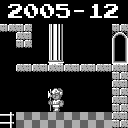
| Game: Kid Icarus: Of Myths And Monsters (Nintendo, Game Boy) Compiler: RyuMaster | For this month's "Maps Of The Month" featurette, I wish to draw your attention to RyuMaster's Kid Icarus: Of Myths And Monsters (Game Boy) maps.
RyuMaster has long been deserving this honour. Check out the Game Boy section; he practically owns it. It's not much, but Merry Christmas, RyuMaster! He has been one of the most giving gamers, holiday season or not. Of the many maps he has contributed to VGMaps.com from the original gaming handheld, one of his most recent and one of his best works is of Kid Icarus: Of Myths And Monsters. It's a follow-up to Kid Icarus, and the last that we've seen of the Nintendo underdog Kid Icarus (not counting the mere trophy figurine in Super Smash Bros. Melee). Pit's quest to obtain the Three Sacred Treasures to save Angel Land is not a simple one. He must traverse the Under World Tower, the Over World, and the Sky World Tower in order to stop the invasion of the Orcos. Just like the NES game, you'll help Pit through these worlds that are mostly horizontal or vertical, followed by a complex fortress that will test your navigational prowess. Or you could always use RyuMaster's maps as a guide. He's even made up maps for all the little shops, information centers, and other rooms you may encounter along the way! So to recognize the effort put into making these thorough and deserving maps, RyuMaster's Kid Icarus: Of Myths And Monsters maps will be known as VGMaps.com's Maps Of The Month for December 2005. | 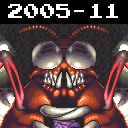
| Game: Secret Of Evermore (Squaresoft, Super NES) Compiler: Grizzly | For this month's "Maps Of The Month" featurette, I wish to draw your attention to Grizzly's Secret Of Evermore (Super NES) maps.
The game cartographer, Grizzly, is one of those who makes unique choices of games to map. Most of his maps are from games not well-known, but are apparently worth spending time on. Of the games he's mapped, Secret Of Evermore for the Super NES is probably one of his best-known games, and definitely among his best work so far. And, in many ways, these are the kinds of maps that VGMaps.com needs more of. It's a Super NES game, so it fits into the most popular section here. It's an RPG, which is a genre that needs the most maps. It's complete, which means that you could use them while playing the game from beginning to end. And it's labeled with item locations and other useful information, making it particularly helpful along the way.
Secret Of Evermore is an action RPG developed by the American branch of the RPG king, Squaresoft. It was likely made in an attempt to repeat the success of Square's Secret Of Mana, but has no relation to the Mana (or Seiken Densetsu) series, other than its similar form of gameplay (and a similar title). Evermore is not as popular as the longer and more epic Mana game of which it was based, but it's still quite an enjoyable game in itself.
A movie-obsessed boy and his dog accidentally find their way into a world called Evermore. It's a dangerous world with multiple areas representing different ages, but you are certainly capable of making it through. The dog can change its form, the boy is armed with alchemy skills, and you have Grizzly's maps.
So to recognize the effort put into making these complete and labeled maps, Grizzly's Secret Of Evermore maps will be known as VGMaps.com's Maps Of The Month for November 2005. | 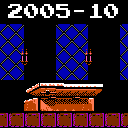
| Game: Castlevania (Konami, NES) Compiler: Revned | For this month's "Map of the Month" featurette, I wish to draw your attention to Revned's Castlevania (NES) map. Castlevania is a one of the longest running game series that hasn't grown stale yet. Sure, the plot usually involves Dracula coming back, and requiring a slaying (an apparently temporary sort of death) by the whip of a vampire hunter, usually, though not always, of the Belmont family. There are a few variations - who helps Dracula return, the layout and nature of the castle itself, how the main character(s) get involved, when it happens (a couple games even take place in the future!) - but more than plot, the gameplay is usually tweaked with each game as well. Some games are really quite different from each other. Some are very linear and arcade-like, and some are more complex adventures, like the more recent Super Metroid-inspired games. Castlevania has appeared on multiple game consoles, most in 2D and some in 3D. But you can still depend on a couple things: the graphics and the music are always top-notch! Though the series started out as Vampire Killer on the MSX Home Computer in 1986, most people first encountered Konami's version of Dracula here in a tweaked version of that game, known as Castlevania. So it's generally regarded as "the original" (even if Super Castlevania IV rewrites it plot-wise). Vampire Killer, however, has maps built-in. Castlevania doesn't. Which is why Revned stepped up to bat. (Yes - pun very much intended.) Revned was the very first Mapmaker of the Month in May of 2004 and now claims that honour again with his single map of all of Dracula's Castle. Its beautiful 8-bit gothic architecture shows that even back in 1987 a video game console could make you feel like you were in a eerie castle. And if you lacked that imagination, of which not much should've been required, at the very least you could say it had great graphics for its time. So it deserved to be mapped, and that mapper deserving of a Mapmaker of the Month title. So to recognize the effort put into making this all-encompassing and classic map, Revned's Castlevania map will be known as VGMaps.com's Map of the Month for October 2005. | 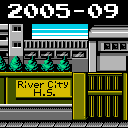
| Game: River City Ransom (Technos, NES) Compiler: Osrevad | For this month's "Maps Of The Month" featurette, I wish to draw your attention to Osrevad's River City Ransom (NES) maps. It's September, so for many people it means a time to go back to school. If you're going to River City High, watch out for bullies that will try to make you drop your lunch money, make friends with some Generic Dudes, try hopping up onto the basketball hoop in the gym to get to your second floor classes, and don't forget to study from your Stone Hands textbook. River City Ransom is an amazing game for the NES. It's much more than a beat-'em-up like, say, the Double Dragon games. What makes this game stand out are its light RPG elements and 2D sprite physics. RPG elements include stats that are affected by what you buy in the many shops in the game. You can eat some food or read a book or even buy a teddy bear, any and all of which could increase your stats to help you survive your fights. And certain books will teach you skills, like Stone Hands and Dragon Feet, which will let your limbs fly rapidly in melee combat. And those are just the basic ones. But even the more "complex" fighting techniques are easy to do before long, which is very intuitive when you consider that it involves a controller with only two main action buttons. You can also fight with a variety of items, which is where the sprite physics really come into play. Crates, tires, and other objects, including your enemies, can be thrown, smacked, or bounced into enemies. Some items can be stood on, as well. If you and a second player were skilled, it could be quite a circus scene if you threw a tire, let it bounce off a wall, grabbed a crate, jumped on the rolling tire, had your partner jump onto the crate that you're holding while they're holding a knocked-out enemy, and then you throw yourselves and the whole mess into a crowd of thugs...well, it's just a lot of fun to try and do. Osrevad gets two Maps Of The Month honours in a row. Maybe I just couldn't resist putting a game with a map of a school for September...but, hey, I'm also feeling nostalgic. River City Ransom is a game I've played over and over, and I'm sure many of you have. And if you haven't played it, why not try it out? With Osrevad's maps, you can't get lost. (They'll also work for the GBA remake, River City Ransom EX, a game that builds on the original with new objects to fight with, and the ability to recruit boss characters!) The River City map is the widest map on the entire site, and there's also a map for the boss-laden River City High. So to recognize the effort put into making this nostalgic maps, Osrevad's River City Ransom maps will be known as VGMaps.com's Maps Of The Month for September 2005. | 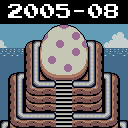
| Game: The Legend Of Zelda: Link's Awakening DX (Nintendo, GBC) Compiler: Osrevad | For this month's "Map of the Month" featurette, I wish to draw your attention to Osrevad's The Legend Of Zelda: Link's Awakening DX (GBC) map. (The map that is honoured this month was the source of this year's April Fools' Day joke. But this map is from a real game.) As mentioned in the April Map Of The Month blurb, The Legend Of Zelda: Link's Awakening was originally released in 1993, and later remade as The Legend Of Zelda: Link's Awakening DX, a colourized version for the Game Boy Color. The Game Boy Color version was essentially the same adventure involving Link's quest to awaken the Wind Fish in order to escape an island which may in fact be the Wind Fish's dream. But in addition to that, there was now a new dungeon in which colour played an important role, and the chance for Link to don a blue or red tunic like those seen in some of the other Zelda games. Nintendo thought this game was worth doing a remake of, and Osrevad thought this game was worth mapping. Similar to how the Super NES's The Legend Of Zelda: A Link To The Past was a very square world, the island of Koholint here turns out to be very much a rectangle. It's efficiently laid out, aesthetically pleasing, and now also in colour. Practically desktop wallpaper material. So to recognize the effort put into making this beautiful overworld map, Osrevad's The Legend Of Zelda: Link's Awakening map will be known as VGMaps.com's Map of the Month for August 2005. | 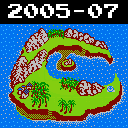
| Game: StarTropics (Nintendo, NES) Compiler: Chiasm | | For this month's "Maps Of The Month" featurette, I wish to draw your attention to Chiasm's StarTropics (NES) maps. StarTropics is a Zelda-esque game. With a tropical twist! Perfect for a summer month like July. (TRIVIA: StarTropics is a game that was developed by Nintendo, but was not published in Japan.) You play a somewhat-generically-named guy named Mike Jones. He goes to visit his uncle on tropical C-Island, only to find that he's been abducted. Over the course of the first six chapters, you will traverse numerous islands, meet a robot buddy, turn into a girl, get swallowed by a whale, sink a pirate ship, dive deep under the sea, and deal with creatures ancient and supernatural before finding him. Then in the final two chapters, you bring the fight to your uncle's abductors to prevent them from endangering the entire world. When you walk about the islands, it's similar to some RPGs, with an overhead view and NPCs to talk to. Then when you enter an action area such as a cave, the perspective comes in closer and you as Mike Jones will brave the dangers inside. The islands have plenty of caves and tunnels, split up into slightly puzzlish rooms, hence the comparison to The Legend Of Zelda games. Though to be fair, StarTropics has its own gameplay mechanics; Mike Jones can actually jump, and knowing where and how to jump is the key to many of those puzzles. Chiasm (a previous Mapmaker of the Month) has enjoyed this above-average NES game and the layout of both its outside and inside areas. Everything is fully mapped, with helpful labels of things, and the marking of false exits and walls that you can walk through make it functional for when you need help getting through this adventure. So to recognize the effort put into making these beautiful and functional maps, Chiasm's StarTropics maps will be known as VGMaps.com's Maps Of The Month for July 2005. | 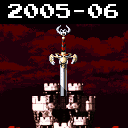
| Game: Super Mario RPG: Legend Of The Seven Stars (Nintendo/Squaresoft, Super NES) Compiler: Peardian | | For this month's "Maps Of The Month" featurette, I wish to draw your attention to Peardian's Super Mario RPG: Legend Of The Seven Stars (Super NES) maps. One of the Super NES's best of its later games is a true gem, treasured by many gamers. It is the greatest collaboration between game-maker heavyweights Nintendo and Square; it is the original Super Mario RPG. Later RPGs featuring Mario have been great games themselves, those games being Paper Mario (N64), Paper Mario: The Thousand-Year Door (GCN), and Mario & Luigi: Superstar Saga (GBA). An upcoming sequel to Mario & Luigi is likely to be a fun time as well. But no one can make an RPG quite like Square can - well, at least not in the late '90s on the Super NES, when Square created games still among the top of many RPGamers' lists, such as Chrono Trigger and Final Fantasy VI. Square's take on the world of Super Mario was an expansive one. The Mushroom Kingdom here is just one small area among several. Mixing in new areas and RPG elements into clearly "Super Marioesque" landscapes and gameplay makes this game unique and therefore quite cherished. Peardian was one of the gamers who really cherished it, and he put together all the maps from the game. Besides those "ripped" from the game itself, he has made some beautiful original maps (check out the waterfall and Midas River, for example). Peardian's maps of Super Mario RPG: Legend Of The Seven Stars also have the distinction of being the largest set of maps from a single game that we have here at VGMaps.com, with a whopping 366 of them. So to recognize the effort put into making these numerous and beautiful maps, Peardian's Super Mario RPG: Legend Of The Seven Stars maps will be known as VGMaps.com's Maps Of The Month for June 2005. | 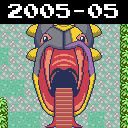
| Game: Pokémon: Emerald Version (Nintendo, GBA) Compiler: Jaromaru | | For this month's "Maps Of The Month" featurette, I wish to draw your attention to Jaromaru's Pokémon: Emerald Version (GBA) maps. Pokémon Emerald came out on American and Canadian store shelves on May 1, 2005. The default name for the female trainer in Pokémon Emerald is May. Emerald is the birthstone for the month of May. So it was a no-brainer, or at least very timely and appropriate, to make the Pokémon Emerald maps the Maps Of The Month for May 2005. Jaromaru has already been a Mapmaker of the Month twice already, for his work on Pokémon maps for FireRed/LeafGreen (September 2004) and Ruby/Sapphire (June 2004). He's a Pokémaniac if ever there was one. But there isn't as much redundancy this time around as you might think. Though Emerald is to Ruby/Sapphire as Crystal was to Gold/Silver and Yellow was to Red/Blue, that is, a beefed-up version with features not found in the original pair of each generation of Pokémon games, Emerald should at least warrant a look with its bevy of new areas, including the huge new Battle Frontier. It will certainly challenge even the best Pokémon Masters. Even the old areas are revamped - it's interesting to compare the Ruby/Sapphire maps with the Emerald ones. Like a "Spot The Differences"-type of game, you could spend a whole afternoon finding differences - small or large, minor or major - that exist in nearly all of the original areas. The basic layout of the areas are still similar enough to make cartographers turn away - so Jaromaru deserves this honour for repeating a difficult task under the constant feeling of déjŕ vu. So to recognize the effort put into (re)making these comprehensive maps, Jaromaru's Pokémon: Emerald Version maps will be known as VGMaps.com's Maps Of The Month for May 2005. | 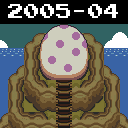
| Game: The Legend Of Zelda: Link's Awakening Advance (Nintendo, GBA) Compilers: JonLeung (with some help from Osrevad) | | For this month's "Map of the Month" featurette, I wish to draw your attention to JonLeung and Osrevad's The Legend Of Zelda: Link's Awakening Advance (GBA) map. A rare game this is, even in Japan, offered only as a pre-order bonus for The Legend Of Zelda: The Minish Cap (much like how The Legend Of Zelda: Ocarina Of Time & Master Quest were pre-order bonuses for The Legend Of Zelda: The Wind Waker). Quite a gem, this game. Originally released as Link's first Game Boy adventure in 1993, it has been remade once before as The Legend Of Zelda: Link's Awakening DX, a colourized version for the Game Boy Color. The Game Boy Color version was essentially the same adventure involving Link's quest to awaken the Wind Fish in order to escape an island which may in fact be the Wind Fish's dream. But in addition to that, there was now a new dungeon in which colour played an important role, and the chance for Link to don a blue or red tunic like those seen in some of the other Zelda games. This Game Boy Advance version has new challenges, like figurine collecting previously featured in The Wind Waker and also The Minish Cap, and a new dungeon which showcases the GBA's abilities. Of course, there are further improved graphics, on par with the Super NES, making this game look remarkably like The Legend Of Zelda: A Link To The Past. With a little help from fellow game cartographer Osrevad, JonLeung (that's me!) has captured the island of Koholint in all its multi-coloured glory. (JonLeung's note: Normally I wouldn't pat myself on the back, but April is a very special month. It includes my birthday, among other things. Like April Fool's Day.) So to recognize the effort put into making this beautiful map, JonLeung and Osrevad's The Legend Of Zelda: Link's Awakening Advance map will be known as VGMaps.com's Map of the Month for April FOOLS' 2005. | 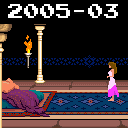
| Game: Prince Of Persia (Jordan Mechner, PC) Compiler: TerraEsperZ | | For this month's "Maps Of The Month" featurette, I wish to draw your attention to TerraEsperZ's Prince Of Persia (PC) maps. Long before the Prince Of Persia encountered The Sands Of Time and unleashed the Warrior Within, the Prince Of Persia was still a force to be reckoned with, starring in a game that is considered quite a classic. If you had a Mac, Amiga, or PC back before computers were commonplace, you must've at least heard of the original Prince Of Persia. It got ported over to several consoles and handhelds, as well. The animation of the main character, the Prince-to-be, is amazing, probably helping its impressiveness at the time. The game itself was also unique, and required a greater degree of concentration than most. The game is an adventure, but the game couldn't really be called a platformer. It takes more skill than just jumping around. Falls will hurt or kill you. Traps are all around, and require timing to get across safely. You must carefully jump and climb up ledges, then quickly pull out your sword (after you've found it, of course) to dispatch guards with careful swordplay. Other than a couple small increases to his life meter, he doesn't really get stronger as the game progresses - the player must rely on his/her own improving skills to defeat Jaffar and make it to the Princess in time. If you haven't at least tried the original, you're missing out on a milestone in gaming history. TerraEsperZ becomes a two-time Mapmaker of the Month this March. (His first honoured works are the maps for an underrated NES game, The Goonies II.) It takes a fair bit of skill to play this game, so I imagine it would take a fair bit of skill to be mapping it along the way. Great job, TerraEsperZ! So to recognize the skilful effort put into making these complete maps, TerraEsperZ's Prince Of Persia maps will be known as VGMaps.com's Maps Of The Month for March 2005. | 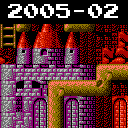
| Game: Faxanadu (Hudson Soft, NES) Compiler: Timothy1979 | | For this month's "Map of the Month" featurette, I wish to draw your attention to Timothy1979's Faxanadu (NES) map. Faxanadu is quite a gem. Released in the middle of the NES era (well, except for in Europe, where it came considerably later), Faxanadu is a game unlike most other video games at the time. It's one of the first action-adventure-RPG hybrids, and it seems to be a cult favourite, as some gamers still play it. The graphics are stupendously detailed, kind of like in Blaster Master, more than most developers would have found necessary at the time. The colours start out all earth-toned, but the palette opens up considerably as you progress further into the game. Not unusual in the worlds of many RPGs and adventure games (and many other things that take place in a fantasy setting) is a large tree. In some cases it's the source of magical energy, or life energy, or something important which requires a tree's longevity. In Faxanadu, the large tree here is called The World Tree, and as befits its name, there's practically a whole world inside it. Towns of people, caves with monsters, and castles of villains are just some of the locales found within. How does one get around this labyrinthine tree? Perhaps ask a squirrel for directions? Or better yet, using the map that Timothy1979 has made! The map retains every pixel of detail and shows the entire World Tree. Kudos should definitely be given to someone who puts together a map of this size for a game that's been played by too few. Perhaps this will open some eyes to revisiting this classic. So to recognize the effort put into making this large and complete map, Timothy1979's Faxanadu map will be known as VGMaps.com's Map of the Month for February 2005. | 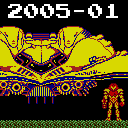
| Game: Metroid II: Return Of Samus (Nintendo, Game Boy) Compiler: Zeric | | For this month's "Maps Of The Month" featurette, I wish to draw your attention to Zeric's Metroid II: Return Of Samus (Game Boy) maps. Samus Aran has become hugely popular in recent years, so why not revisit this Game Boy classic? (SPOILERS & TRIVIA: Samus's adventures have been strikingly similar in basic plot to the Alien movies. (At least if you ignore the recent renumerization of Prime as her first mission and the remake of the original Metroid, Zero Mission, as her zeroth mission...oh, and Metroids probably never faced off against Predators...) In this second adventure, similar to James Cameron's Aliens (1986), our heroine goes to the home planet of the alien menace that was introduced in the first. It ends after a face-off against the Queen, but not before our heroine takes a specimen of this alien species with her when she leaves the planet. Almost freaky, those similarities. I hope I didn't just ruin the Metroid and Alien series simultaneously for you readers. (Anyway, if it were up to me, I would've moved Super Metroid's opening sequence to the end of Return Of Samus, if only to get Ridley and an escape sequence into more Metroid games. Plus, more games need cliffhangers.)) SR388 differs from Zero Mission's, the original Metroid's, and Super Metroid's Planet Zebes in that a full map of this planet's caverns cannot be viewed perfectly connectedly on a 2D plane. You'll notice that the tunnels can take you around to somewhere you wouldn't expect. It can be quite confusing, and even Metroid fans will get lost. Add to the fact that the rooms are often very similar and only in four colours. At least, they're normally only in four colours, this being a Game Boy game. Apparently, like Link's Awakening, there were plans to remake this Game Boy classic into a Game Boy Color game with, obviously, colour. I could be wrong, but as far as I know, it was never officially released, but these maps show what such a game could have looked like. Zeric also includes enemy locations, marked boss and item locations, and hints of secret passageways. If the over-six-megabyte image is too large for your computer to handle, he was nice enough to make separate maps for certain areas. The example of perfect mapmaking if ever there was one. So to recognize the effort put into making these beautifully coloured and very useful maps, Zeric's Metroid II: Return Of Samus maps will be known as VGMaps.com's Maps Of The Month for January 2005. |
Congratulations and thanks to the Mapmakers of 2005! 
|